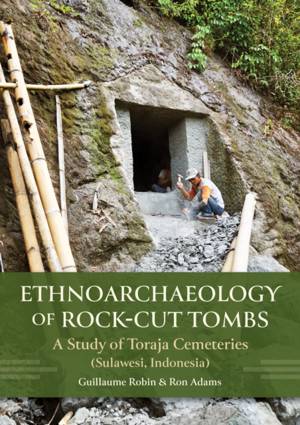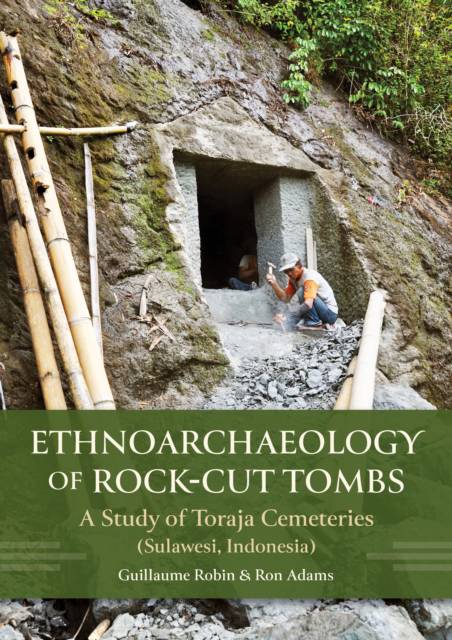
- Afhalen na 1 uur in een winkel met voorraad
- Gratis thuislevering in België vanaf € 30
- Ruim aanbod met 7 miljoen producten
- Afhalen na 1 uur in een winkel met voorraad
- Gratis thuislevering in België vanaf € 30
- Ruim aanbod met 7 miljoen producten
Zoeken
Ethnoarchaeology of Rock-Cut Tombs
A Study of Toraja Cemeteries (Sulawesi, Indonesia)
Guillaume Robin, Ron Adams
€ 63,95
+ 127 punten
Omschrijving
Explores the living tradition of rock-cut tombs (liang pa') in Sulawesi, Indonesia, offering new insights into their architecture, rituals, and social contexts.
Rock-cut tombs, i.e. chambered tombs hewn out from the bedrock, were a common type of monumental burial among many past societies around the world, from the Neolithic Mediterranean, to the Classical Near East, and Protohistoric Japan and Korea. Around the globe they have attracted the attention of generations of archaeologists, historians and art historians. The island of Sulawesi, Indonesia, is the only place where rock-cut tombs are still being created today, and in a traditional (small scale, animist) society context. The Toraja people of Central Sulawesi have built and used rock-cut chambered tombs (locally called liang pa') as kinship communal burials for at least 300 years. This living tradition represents a unique opportunity to study rock-cut monuments from an ethnoarchaeological perspective, with a focus on their material, temporal, social, ritual and landscape dimensions. This book is the first ever dedicated to the Toraja tombs and is the outcome of comprehensive literature-based research (ethnographic literature from the 19th century to present) and original fieldwork carried out by the authors in June 2017. The aim of the book is twofold: first, to provide an overview of liang pa' rock-cut tombs and, second, to address specific issues that had never been investigated before. These issues include the architectural style and decoration of the tombs, the technical steps and ritual activities associated with the process of cutting the tombs into the rock, their landscape setting, and their relationship to local kinship groups. The authors place the liang pa' within the context of historical developments pertaining to other funerary traditions of the Toraja people over the past several centuries, and present an overview of burial practices associated with these monuments. The research provides a unique synthesis and offers methodological and theoretical insights that are relevant to any reader interested in rock-cut architectures of the past and present, monuments and rituals, and the anthropological study of human-environment interactions. Overall, the book offers a series of fresh insights on long-debated archaeological issues that will inform discussion and theoretical models for the study and interpretation of ritual monuments from prehistory to present.
Rock-cut tombs, i.e. chambered tombs hewn out from the bedrock, were a common type of monumental burial among many past societies around the world, from the Neolithic Mediterranean, to the Classical Near East, and Protohistoric Japan and Korea. Around the globe they have attracted the attention of generations of archaeologists, historians and art historians. The island of Sulawesi, Indonesia, is the only place where rock-cut tombs are still being created today, and in a traditional (small scale, animist) society context. The Toraja people of Central Sulawesi have built and used rock-cut chambered tombs (locally called liang pa') as kinship communal burials for at least 300 years. This living tradition represents a unique opportunity to study rock-cut monuments from an ethnoarchaeological perspective, with a focus on their material, temporal, social, ritual and landscape dimensions. This book is the first ever dedicated to the Toraja tombs and is the outcome of comprehensive literature-based research (ethnographic literature from the 19th century to present) and original fieldwork carried out by the authors in June 2017. The aim of the book is twofold: first, to provide an overview of liang pa' rock-cut tombs and, second, to address specific issues that had never been investigated before. These issues include the architectural style and decoration of the tombs, the technical steps and ritual activities associated with the process of cutting the tombs into the rock, their landscape setting, and their relationship to local kinship groups. The authors place the liang pa' within the context of historical developments pertaining to other funerary traditions of the Toraja people over the past several centuries, and present an overview of burial practices associated with these monuments. The research provides a unique synthesis and offers methodological and theoretical insights that are relevant to any reader interested in rock-cut architectures of the past and present, monuments and rituals, and the anthropological study of human-environment interactions. Overall, the book offers a series of fresh insights on long-debated archaeological issues that will inform discussion and theoretical models for the study and interpretation of ritual monuments from prehistory to present.
Specificaties
Betrokkenen
- Auteur(s):
- Uitgeverij:
Inhoud
- Aantal bladzijden:
- 208
- Taal:
- Engels
- Reeks:
Eigenschappen
- Productcode (EAN):
- 9798888572207
- Verschijningsdatum:
- 30/10/2025
- Uitvoering:
- Paperback
- Formaat:
- Trade paperback (VS)
- Afmetingen:
- 170 mm x 239 mm
- Gewicht:
- 562 g

Alleen bij Standaard Boekhandel
+ 127 punten op je klantenkaart van Standaard Boekhandel
Beoordelingen
We publiceren alleen reviews die voldoen aan de voorwaarden voor reviews. Bekijk onze voorwaarden voor reviews.








